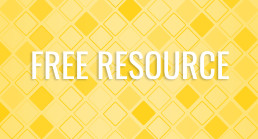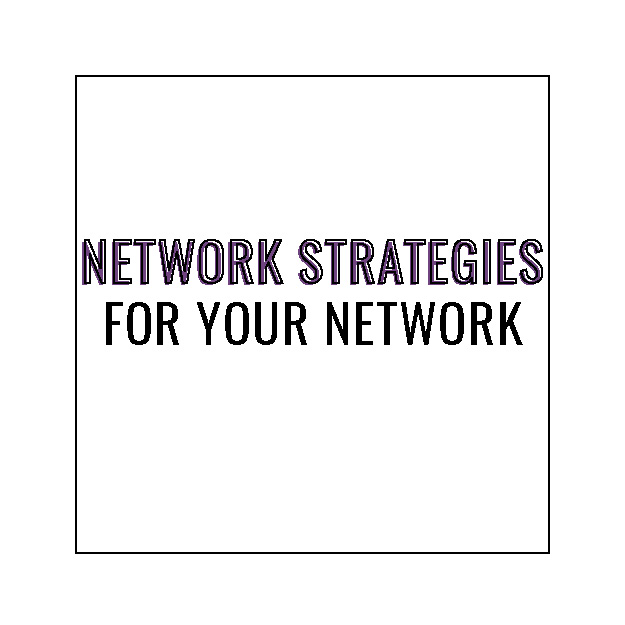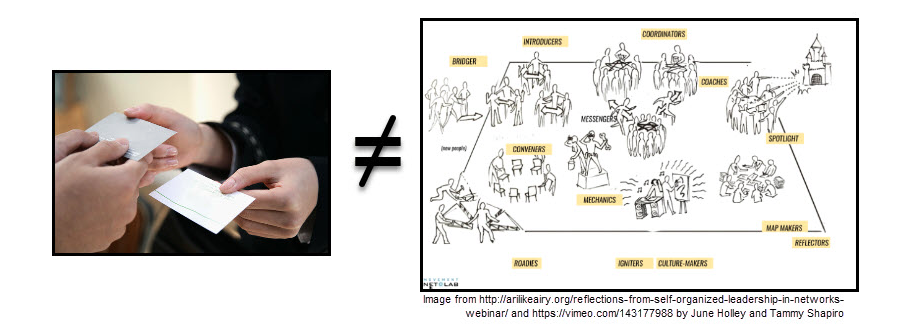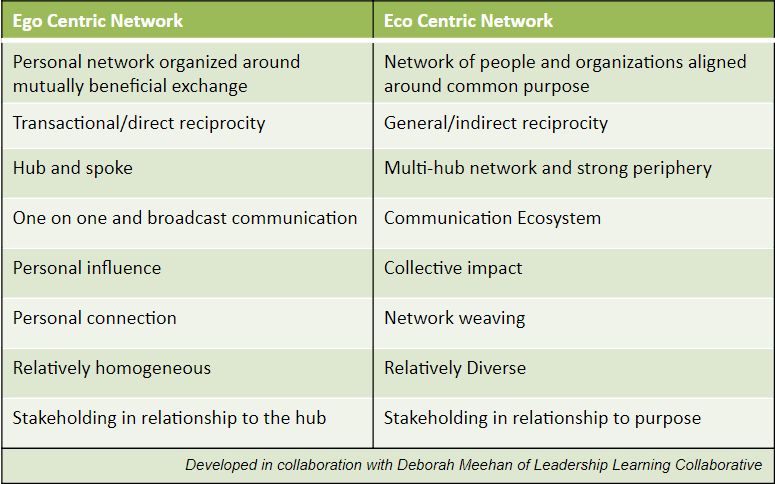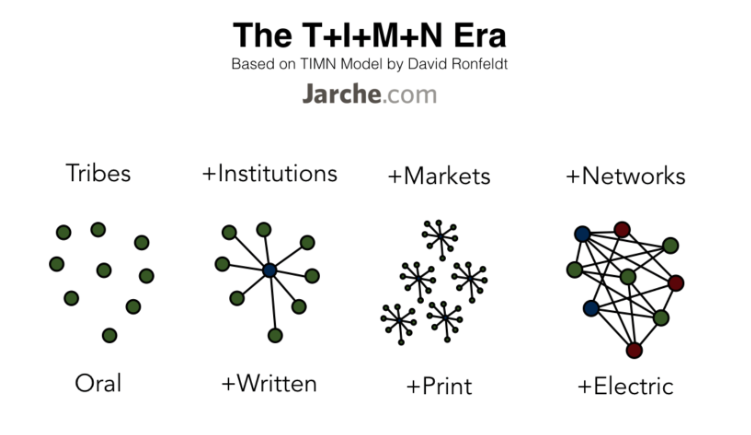What’s Our Job?: Getting Clear on Network Functions
[ap_spacing spacing_height="20px"]
As I’ve worked with a variety of social change networks to launch or transition from one stage to another, I’ve been guided by the following formula:
[ap_spacing spacing_height="20px"]
Form follows function follows focus
My experience is that many groups and initiatives can get very concerned about structure – How will we make decisions? Who will be members? What is expected of them? What do they get in return? These are important questions, and they deserve a fair amount of time tending to them. What can bog many groups down at this stage, however, is that they have not sufficiently sorted out the functions of the network, how it creates value, if you will, which has important implications for form. And if the group is not clear on its focus (purpose, animating goal, mission), this can be that much more perplexing.
So I’m spending more and more time with networks sorting out their core “jobs,” with a few additional guiding mantras, including:
[ap_spacing spacing_height="20px"]
Do what you do best and connect to the rest.
The value proposition of change networks in my mind is that they add value to a broader landscape of activity, not that they come in and try to take over. Even if this is not the intent, groups can spend little time figuring out what already exists “out there,” what efforts are underway, what other collective efforts are operating. This lack of awareness risks creating unnecessary and unhelpful duplication and competition.
From an ecosystem perspective, each living organism finds a particular niche (what it does best and where) and contributes to the broader whole. I recently met with a network that did some important work sorting out what the jobs of the network as a whole are versus the functions of its individual members. For example, members decided it is NOT the work of the network to create curricula; that’s what members do. It is the job of the network to disseminate these, to make them more broadly accessible and to create a portal that draws more attention to a variety of educational resources that can meet a diversity of needs. Furthermore, the network decided its job was NOT advocacy, since another group already did this work quite well, but it could provide a great service alerting members and others to important campaigns and organizing efforts.

Another guiding mantra:
What value can we create through connection and flow?
There are really the two main ways that networks achieve what are called “network effects” (such as resilience, adaptation, small world reach …). If we are not talking about how a network does its work through leveraging, adding and shifting patterns of connection and flow, then we really are not bringing a network mindset to net work. When we do, this can help illuminate areas for adding and creating value – for example, bridging across various kinds of boundaries, temporal, geographic and cultural, or amplifying otherwise unheard or less resourced members.
Recent work with another network yielded the following list of functions, which they are continuing to play with:
[ap_spacing spacing_height="10px"]
- Build trusted relationships between multiple sectors and communities [ap_spacing spacing_height="10px"]
- Convene partners across state and sectors [ap_spacing spacing_height="10px"]
- Generate conversation among diverse partners [ap_spacing spacing_height="10px"]
- Identify newly arising (systemic) barriers so they can be addressed [ap_spacing spacing_height="10px"]
- Provide greater access to technical assistanceproviders [ap_spacing spacing_height="10px"]
- Facilitate access to relevant expertise (including lived experience), information and resources [ap_spacing spacing_height="10px"]
- Disseminate information about innovative approaches and policy priorities [ap_spacing spacing_height="10px"]
- Disrupt the status quo in the name of creating system change (ex. support litigation) [ap_spacing spacing_height="10px"]
- Contribute to movement; use innovation and creativity to inspire people to action [ap_spacing spacing_height="10px"]
- Curate relevant data, information, planning documents and other resources, and ensure community input is reflected [ap_spacing spacing_height="10px"]
What about you and your network(s)? What functions are you finding add the greatest value? How are you determining what you do best as a network, and where, and how you contribute to others?
originally published on 9/12/18 at Interaction Institute for Social Change
The Power of Networks
If you’re like most nonprofit leaders, you’re devoting significant effort to your networks. But what return are you seeing on that investment?
I recently spoke with 500+ nonprofit leaders at Nonprofit Driven 2018 and emphasized 3 simple truths about strong, impactful networks.
[ap_spacing spacing_height="30px"]
1. Network leadership is different from organizational leadership.
[ap_spacing spacing_height="10px"]
Organizations tend to have strong, stable structures and centralized decision-making. Leaders prioritize goal achievement, alignment and retention.
Networks are loose, unstructured webs of relationships. People are engaged in autonomous yet connected activities to achieve a shared purpose. Activities are emergent and often undefined; people come together when there is energy and opportunity. Network leaders have to be humble co-leaders that lift their gaze above individual organizations to see a greater purpose.
[ap_spacing spacing_height="30px"]
2. Networks are grounded in trusting relationships.
[ap_spacing spacing_height="10px"]
The success or failure of networks can usually be traced to the condition of their relationships. Like any relationship, trust is key. Easy to say, but how do you do it?
[ap_spacing spacing_height="15px"]
I. Visualizing your network can offer powerful insights.
Network mapping can be a powerful trust building process, especially when you engage network members in making sense of it together. Seeing the system of relationships can illuminate barriers and opportunities to build equity and trust.

In some networks, one person (the hub) knows many individuals who aren’t connected to each other (spokes). This can limit and potentially block the flow of information and resources.

II. Closing triangles.
Hubs need to “close the triangles” – build relationships between disconnected people. Closing triangles is a key strategy for weaving ecosystems of trust in which:
• People are meaningfully engaged
• There aren’t gatekeepers
• Diverse perspectives can be fully integrated, and
• Leadership is shared.

III. Set the table for inclusion.
How you set up a room, design an agenda and facilitate a dialogue can either limit or build engagement and inclusion. I recommend Liberating Structures, a set of creative yet systematic facilitation tools that leverage everyone’s contributions.
[ap_spacing spacing_height="30px"]
3. Networks enable community building and social impact.
[ap_spacing spacing_height="10px"]
To make a social impact, networks also need to take collective action. Here are four essential practices:
[ap_spacing spacing_height="15px"]
I. Foster shared purpose.
Shared purpose sustains momentum. Prioritize the purpose and align your strategy to realize it.
[ap_spacing spacing_height="15px"]
II. Foster co-creation.
Mechanisms like Liberating Structures and purpose-driven working groups enable co-creation and build shared ownership.
[ap_spacing spacing_height="15px"]
III. Foster collaborative leadership.
Shared power is key in networks. Regularly analyze how the network is functioning, close the triangles and guide the work together.
[ap_spacing spacing_height="15px"]
IV. Foster generative learning.
Make space to reflect and gather the collective wisdom. Nurture a culture of curiosity and develop agility through learning.
Have you unleashed the power of your networks? Integrating these 3 simple truths and a few proven practices can help make your networks effective and impactful.
[ap_spacing spacing_height="10px"]
Lisa Watson is the Co-Founder & CEO of Openly, a strategy, research and design firm enabling changemakers to achieve social impact. She is also a faculty member at the Banff Centre for Arts & Creativity.
Originally Published on November 8, 2018 at Hilborn: Charity eNews
[ap_spacing spacing_height="15px"]We encourage you to comment on this post so we can hear about your thoughts and experience.
Network Strategies For Your Network
This video is about 20 minutes long and provides a short overview of network strategies. It was done for the Food Policy Network State Networks, who graciously agreed to let me share it.
The video emphasizes the importance of being part of networks of networks and of catalyzing self-organizing to move us to a more experimental, learning and viral space.
Networks of networks and self-organizing are the key factors needed to shift systems.
[ap_spacing spacing_height="10px"]
What’s With The Network Weaving Thing?
[ap_spacing spacing_height="20px"]
I became a rabble-rousing, injustice-fighting, demonstrating, boycotting, marching, chanting, banner-carrying, strategizing, counter-culture activist early
– by age 13 I’d faced my first line-up of National Guardsmen un-accompanied by any adults who knew me.
By my mid-20’s, though, I was utterly disenchanted. The issues were still real & unacceptable, but activism had proven ineffective. Nothing ever really changed.
The direct-attack approach just burned through energy and resources, without getting anywhere near the roots of the problems. We were all too far outside the systems that needed to change – those systems were too well-protected.
Activists were hysterical misfits attaching themselves aimlessly to random causes, more for the adrenaline & thrill of disruption than out of commitment to anything in particular. I tired of the endless power-struggles, and people projecting their own unacknowledged emotional problems onto larger social issues (which, you know, maybe I was still doing a little of that myself. . .).
Plus, by then I was a single mom & needed to support my kid. I settled down, quit tilting at windmills and became pragmatic. Well, I tried to anyway.
Ultimately, I discovered that activists were no more dysfunctional than other groups – they just had fewer carrots & sticks to keep things focused was all.
My need to make things better shrank down to the confines of my employer organizations & specific work-related initiatives, but even so, change was hard work. And regardless of context, carrots & sticks seemed crappy substitutes for passion, intrinsic motivation and vision.
[ap_spacing spacing_height="20px"]
Some questions can’t be avoided
So the question still was – how can groups of people work together more effectively to solve problems – without coercion? And without the financial reward that imposes it’s own priorities, and inherently skews solutions toward the market, whether market solutions are appropriate or not? Or maybe more to the point – how do you access the passion & motivation & vision inherent in all would-be change-agents in a way that helps them fulfill their own personal missions while still moving toward larger collective goals?
I contemplated those questions so long that I decided to get a Master’s Degree in Organizational Leadership – and discovered Wheatley, Senge, Bohm, Scharmer, Kahane, Meadows, Semler, Argyris and so on & so on & so on.
I found a whole new world of systems thinking, collective wisdom, dialog, self-organizing systems, complexity – it all was exactly what I’d been missing all those years. I was in intellectual heaven, completely engrossed. I felt like I’d found the key to the Universe.
At first I tried to apply what I was learning in my work-place – not so successfully. Eventually I realized that profit-oriented hierarchies aren’t the best fit for the approaches I was interested in. I wasn’t positioned to change the secretive, hoarding, clinging, fearful, linear, bottom-line, controlling minds at the top – and eventually realized it was stupid to even want to – just more tilting at windmills.
I moved on to experimenting in the real world – in loose groups gathering around causes & ideas, collectives trying out new ways of working together, etc.. This was a better fit, a more conducive context. But still, collectivity & change were hard.
There were all these lovely new methodologies – Appreciative Inquiry, World Café, Open Space Technology, Dialog, Theory U, Human Systems Dynamics, Scenario Planning, Theory of Constraints, Design Thinking, etc., etc. – most of which, though wonderful, seemed best suited to more bounded & narrowly defined situations. Or are applicable to smaller groups, or larger groups. Or less diverse groups, or ones with smaller gaps in privilege & equity, Or they require a ton of time, money, expertise and planning. Or they’re so conceptual & abstract that people mired in real-world, right-now issues just can’t focus on them long enough to give them a chance. Or else . . .
[ap_spacing spacing_height="20px"]
I’d found a key, but for which door?
I wasn’t looking for the keys to corporate change – I was stalking change & emergence in self-selecting groups attempting to make huge differences. I was back to my activist roots, wanting to solve the big, big problems, like poverty & ecological sustainability, white supremacy & urban livability & climate change. Big overlapping, complex problems that require collaboration & passion across all kinds of differences. Problems that demand more than one vision, myriad visionaries, multiple strategies & that won’t oblige central command & control.
And the thing is – the answers are still emerging. There’s a ton of good work going on, but everyone is still learning. There’s no one size fits all. We’re not ‘there’ yet (if ‘there’ even exists anymore, or ever did).
Anyway – all of that above is my long-winded way of telling you my bona-fides, my credentials – why I feel qualified to say what I’m going to say next. Which is:
Network Weaving is darn close.
So, if Self-organizing is the key, then Network Weaving is the lock and the door & the turning bolt & the handle & the hand & the doorframe & the. . . you get the point. I don’t mean it’s the only key, or the be-all or end-all. But it’s scalable, flexible & fits a lot of contexts.
I wouldn’t have suspected that.
[ap_spacing spacing_height="20px"]
I didn’t start out all that psyched about Network Weaving.
It just seemed like another relevant but small piece of the puzzle – of course you need networks, but there’s a lot more to it than that. . . (I think I was still enamored of complexity – I wanted it to be more sublime).
But no – I got to Network Weaving through my background in data analysis, gathering & visualization – I mapped some networks. For money. It was just another opportunity to fiddle on my computer, mess with spreadsheets & make something pretty (a tech-y version of pretty that is) – which is one part of what I’ve done for a living for awhile now.
But it did amplify, in my own mind, the one thing that became crystal clear in all my earlier experiments – just inviting a lot of folks & getting them to the table isn’t enough. Even with all those beautiful methodologies.
If the quality of the connections isn’t high enough to get meaning & value flowing – you just have a lot of happy-talk. And disenchantment. And no change. In spite of shared vision & simple rules & all those other important components.
It all still comes down to the foundation – the interdependence that bonds us together.
If the human bonds at the core of the system aren’t strong & trusting, not much new will happen. And Network Weaving is all about creating, not just connections – but connections that can carry weight. It’s about meaningful connections, resource-sharing connections, mutual-aid & mutual-growth & mutual-survival connections.
So Network Weaving as the way into Self-Organizing just kind of grew on me.
And network mapping as the way into Network Weaving started to seem inevitable – work I had to do.
And I don’t mean just Social Network Analysis (SNA). No, SNA was just another game for data-dweebs. Used in organizational decision-making & marketing & fundraising & influence peddling – also good for researching disease transmission and terrorist cells and other scientific purposes.
No – I quickly became interested in a specific application of Social Network Analysis, and only as a small piece of what I imagined was possible through interactive network mapping.
What became meaningful & exciting to me was the potential for self-organizing & transparency & real resource exchange (just like in a living system) that an interactive, online network map could facilitate. Interactivity promised to enhance the conditions necessary for self-organizing. And while I was trying to figure out cheap ways of making the tools I had at hand more interactive, Kumu.io made a huge leap in that very direction & provided the perfect platform for what I was dreaming up. Which clinched the deal, that was my entry point. A method I could finally get behind & settle into. It was time to absorb everything I could about the Network Weaving methodology.
And, as I did, I started to see that Network Weaving contains the skills, the process & the methods to help self-organizing come into being (without bogging down in theory).
Network Mapping is just one part of the whole picture – the part my husband Tim & I are especially qualified to help with. But I have learned enough about self-organizing & systems & complexity & human trust and passion and intransigence, to recognize that Network Weaving, combined with a good interactive network map designed around your particular network’s specific needs, has the potential to break through all that ineffectiveness that frustrated me about back-in-the-day activism.
It’s not the only or the final answer, but I don’t think you can go wrong to include network weaving & a network map in your collective change efforts. And the purpose of this blog is to help with that.
What’s your experience with Network Weaving? And how could I help enable your network weaving & mapping practice? Please comment below.
[ap_spacing spacing_height="20px"]
originally published at Greater Than The Sum on June 24, 2015
Stories of Network Value and Engagement
Every month Network Weaver has a virtual Consultants Gathering. In August's gathering, the consultants were asked to share stories about their own successful and fulfilling network experiences.
Below are three stories from Network Weaver consultants in response to this question:
“What is a story of a time that a network offered you value and you were excited enough to prioritize engagement with that network? What were the conditions that enabled this?
[ap_spacing spacing_height="30px"]From Aisha Shillingford
A few years ago I was a member of a national network of people working for spiritual and social transformation. Prior to joining I had become aware of the network and felt greatly impressed and inspired by the way the members of the network embodied practices that reflected the values and principles of the network. I deeply desired to join so I could be part of this community that was walking the talk and making a positive impact in the lives of others. I remained part of the network for over ten years.
Reflecting on the conditions that enabled my sustained involvement I thought of the following:
- a clear network structure that allowed people to be involved in the network at different levels of engagement and responsibility.
- a community of support and accountability
- a joyful and meaningful connection to members of the network, true friendships
- a clearly and oft articulated purpose and vision
- opportunities for learning and for contributing to the growth of others
- personal and social development. Self development as well as projects for improving the broader community
- a strong sense of ‘we’, a shared identity
- clear mechanisms of appreciation and votes of trust. These were shown through increased responsibility and participation in decision making etc.
[ap_spacing spacing_height="30px"]From Curtis Ogden
The network that immediately comes to mind is the network I’ve been supporting for almost 7 years now, Food Solutions New England. Though I am technically a consultant, at this point I am very much a member of the family. It was, in some sense, exactly what I was looking for – a “project” to really sink my teeth into and a community where I could find a deeper sense of belonging.
I would say that from the get-go there was something about the quality of the people, the sense of welcome, and of being more authentic and whole with one another that was a draw. People were willing to not just be in their heads, but in their hearts and souls. We shared meals and informal conversation with one another. We shared art and poetry. And there was a sense of truly being in something bigger, a movement, that was larger than any of our individual work. So, trust, authenticity, openness, and compelling purpose all helped.
We have also been committed to diversity, inclusion and equity in a number of different ways, so that there is a commitment to ongoing learning and action, which results in being in rooms with people of a variety of different backgrounds and identities, which is stimulating. Over the seven years of work, there have been threats of plateauing and then we come on another challenge: from building a base of trust, to aligning around a vision, to committing to racial equity, to mapping our system to working on complex solutions, to addressing white privilege and white supremacy culture. Never a dull moment? And we have consistently evolved the structure to meet the needs of where we were moving and growing towards.
I consider the people in this network to be friends, many of whom would really have my back. In this day and age, that feels like an incredible gift.
[ap_spacing spacing_height="30px"]From Kiara Nagel
The network that comes to mind is an international youth network I have been connected to for 10 years now. Focused on internal development and external social initiatives, the network has spun off several different initiatives led mostly by 18-28 year olds.
I think what makes people excited to be involved are:
- deep friendships and many different relationships
- many opportunities for different experiences to collaborate creatively with one another to develop our practices
- collective work that benefits, connects to, and serve others.
There is also an evolving core that brings people back together from time-to-time and shared attention is given to how the economy is developed and the values are practiced
Read more stories in Monday's blog post.
If you have a story you'd like to share, please do so in the comments below, or email info@dev.networkweaver.com
Stories of Network Value and Engagement
Every month Network Weaver has a virtual Consultants Gathering. In August's gathering, the consultants were asked to share stories about their own successful and fulfilling network experiences.
Below are three stories from Network Weaver consultants in response to this question:
“What is a story of a time that a network offered you value and you were excited enough to prioritize engagement with that network? What were the conditions that enabled this?
[ap_spacing spacing_height="30px"]From Yasmin Yonis
At one point some years ago, I was actively engaged with my Truman Scholars Network — listserv posts, meet ups, attending conferences. I was engaged because it was a network of people who shared the same values and same goals as I did—a career in public service—and were passionate about helping each other reach those goals. There was a sense of community and solidarity. We had all survived the infamous Truman selection process and we were in this together. Trumans were in every career field, many of them higher up, and could help you secure connections with others, internships, jobs, and provide help during the graduate admission process. I found some of my best friends in this network.
[ap_spacing spacing_height="30px"]From Sara Shapiro-Plevan
In November 2017, a network of women who had been victims of gender bias or sexual harassment in the workplace, specifically in Jewish communal settings (synagogues, Jewish schools, and Jewish organizations) began to coalesce. Some of us met in a large group in late November and began to self-organize in small groups around particular areas of urgency or interest. For some of us, current events were enough to motivate us to gather, to talk together, and to learn to listen and respond to each other differently. For others, having been victims or caring for victims propelled us to engage with the network and connect with others. Current events swirling around us were no doubt also a motivating factor that we all used to catalyze our engagement with this developing network and our desire to weave the network into something tighter.
We also knew that without the power that lived within this network--predominantly female and with some men who were allies--we would continue to see a culture of complaint without action emerge, and this would be ultimately unsatisfying. Small spots of action began to emerge within the network, through the relationships that came about inside the network amongst trusted network members. Those outside the network were not deemed as trustworthy as those inside--not trustworthy enough to take part in various actions or to hold the stories of those inside the network.
Half a year has passed and real action has emerged from the group. Ideas which were born inside the network have become professional training for people in organizations on the periphery as the changes the network is seeking are becoming diffused. Those trainings are using network models to make sure that they do not stay as trainings alone but create a strong community of partners who can get the work done after they are trained to make change. Advocates from inside the network are moving from the core to the periphery to carry the messages of this work and the value and need for change out into the world and acting as powerful bridges.
Certainly, this is based on current events. When the world can see women as equal and workplaces as equitable, maybe these networks that are being born and coalescing will disappear. But women are taking the reins here and giving birth to these networks, shaping them and making sure that they are strong, using network principles even where they do not know them, and evolving them into something truly captivating.
I myself found two friends inside this network who wanted to work on a project with me, and we have woven our own network as a part of the larger one around hiring as a specific focus, gathering professionals who have been impacted specifically by issues connected to hiring processes. The energy that has been generated inside this has surprised me--it has not been anger alone but has been directed toward change. Where it could have been anger, the network managed to, as a living and breathing entity, steer toward growth and positivity and appreciation, and we are all energized toward a future that can be about connection and equity over disconnect and imbalance.
[ap_spacing spacing_height="30px"]From Joni Bryan
I was fortunate enough during my undergraduate work to be matched with a network weaver extraordinaire as a mentor, Dr. Froswa’ Booker-Drew. Although my networking had been effective previously, it was almost entirely intuitive, and she added science and strategy to it. She also trusted me enough to introduce me to those in her network who could help, or who I could help, and modeled network weaving for me. She introduced me to the idea of social capital and leveraging relationships to make change. Years later, she is still a mentor and a friend to me, and has taught me that every relationship has value and how to strategically align my community to make change. I started a nonprofit community after that, Amplify, and today it is 5 years old and 5000+ members strong - we all rely on each other for the collective knowledge and skills we could never have alone!
More stories to come in Wednesday's blog post.
If you have a story you'd like to share, please do so in the comments below, or email info@dev.networkweaver.com
Network Weaver Free Resources Package
Each week, we add a new free item to our store.

This week we are offering: Network Weaver FREE RESOURCES PACKAGE.
ALL of the free resources currently available at the Network Weaver Resource Page in one complete downloadable file.
Why Networks?
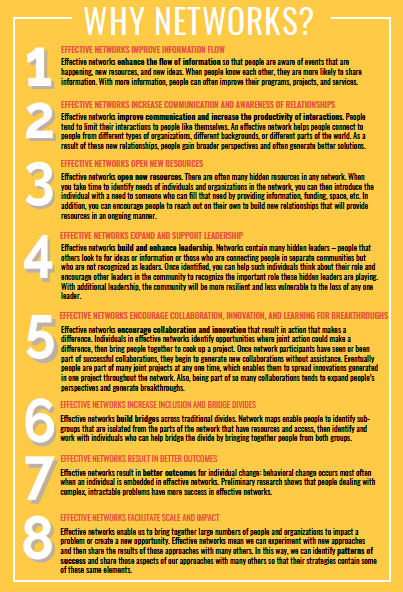
Many people are asked "Why networks?" or "When does it make sense to use a network approach?"
This handout explains all and makes it easy for you to email to someone with a response.
Why Networks? is newly added to our RESOURCES page… and it’s FREE!
To download, CLICK HERE.
Network-ing Does Not Equal Network WEAVING
Those of us who work with change networks could sometimes do a better job of clarifying the distinction between 'networking' and 'network weaving'. Leaving that distinction un-articulated and merely implied inclines those who are new to the discussion to default their hearing to the generic-mainstream meaning of 'networking'. It leaves much of what is important and different about network weaving either un-said, un-heard, mis-understood, or suspect.
Now don't get me wrong - generic 'networking' is indisputably important. Contrasting something to it doesn't mean devaluing it.
And in reality, there's a world of overlap. Either can merge into becoming the other. You could personally be doing one, in the context of the other. And what you think you're looking at depends on where you fit in the network. There isn’t a bright line. My pretense at precise distinction is merely for the sake of nudging us a little further along the spectrum of what's possible.
Because - there's more power and potential in a social network than we've been taught & have grown accustomed to recognizing. And it's hard to access that 'more', if our words limit our imagination. So this is as much about what we're IMAGINING we're doing while we're doing it, as it is about precisely WHAT we're doing.
For those of us who don't resonate to Harvey McKay's 'Swim With the Sharks' and that ilk - the default, mainstream meaning of 'networking' can be a big turn-off . We've come to understand it as a specific, often self-serving, not-necessarily-authentic, social butterflying kind of activity. To many of us 'networking' is a popularity contest - best left to smarmy salesmen, politicians, corporate CEOs & lobbyists. We get a little queasy just contemplating joining those ranks. And no amount of rosy pep-talk convinces us. For introverts and those who value authenticity ‘Networking’ fires up the wrong imaginings.
But beyond being a potential turn-off, the common usage of the word falls short of the vision and purpose behind network weaving. 'Networking' tells the social butterflies they've arrived (an assessment the rest of us can’t agree with), while it leaves much of a network's deeper potential impact and generativity untapped.
We need different words to signal that we're leaving the default meaning behind and talking about something more. And we have them, we just need to use them.
[ap_spacing spacing_height="20px"]A DIFFERENCE RECOGNIZED BY SOCIAL NETWORK SCIENTISTS
Social network scientists have some technical terms that can help us explore this distinction. Terms for different ways of focusing on, or 'scoping' a network for analysis. They are 'ego-networks', 'socio-networks', 'open-networks', and 'eco-networks'.*
I'll say more about 'ego-networks' and 'eco-networks' in a moment, but for the curious, I'll just say this about the other two:
A 'socio-network' is a 'network in a box'. It has clearly-defined, solid boundaries - such as “everyone who works at Company X”, “or everyone who goes to School A” - it only looks at the relationships existing within that boundary - no-one else is relevant.
An 'open-network' is what it sounds like - there are no boundaries. The internet is an open network. Twitter is an open network, Facebook is an open network - anyone can open an account and anyone can be connected to anyone. There is no limit to who might be included in a network map of an open network. In theory, it includes the entire human race (or even further).
*From Understanding Social Networks: Theories, concepts and findings by Charles Kadushin
[ap_spacing spacing_height="20px"]NETWORKING IS TO NETWORK WEAVING WHAT EGO-CENTRIC IS TO ECO-CENTRIC
For our discussion here, the more interesting technical terms are 'ego-network' and 'eco-network', which fit the distinction I'm trying to make almost perfectly. So let's dig in:
An Ego-Network revolves around a core person - it is defined by direct relationships to that central person and doesn't include indirect (2nd degree) relationships or persons unknown to the core person. Sounds a lot like what we get from 'networking', right? It's all about 'me'.
[ap_spacing spacing_height="15px"]What's an Ego-Network?
On a network map it looks like a hub with spokes. The relevant connections are to the single node at the center.
In our society, an ego network is generally connected around support of the core person in some way - important career contacts; the politicians a lobbyist cultivates; the network of family, friends and caregivers around someone with a severe illness, or something like the child support network I was gifted with as a young single mom, made up of sage advisors, friends who babysat regularly (or with whom I swapped regular babysitting) so I could work, friends who would drop everything to come get the kid if I had an emergency, and the kid's dad who gave me big chunks of time off. In that case, the connection to me (and the kid) was what was relevant - whether or not any of them knew one another didn't really matter. There was no larger purpose than helping me out or enjoying my kid.
This is the type of network that 'networking' tries to build and leverage. It is often based on direct reciprocity (I scratch your back, you scratch mine), is personally maintained (I work to maintain the relationship - stay in touch, send gifts, etc.), and often requires a direct match between my needs & yours - if there’s no direct match, there’s no relationship. (i.e. if you can’t help me raise my kid, I have far less reason to sustain our relationship, given my limited time and energy). And it's often homophilic ('like attracting to like') or relatively homogenous. My kid-network consisted entirely of older-moms, current-moms, wanna-be moms & one dad.
And because of their relative homogeneity, ego-Networks can easily become echo-chambers.
If the hub of an ego-network goes away the network falls apart. In an ego-network, the person is the purpose, and without that person, the connections are gone. My marriage (wonderful as it is), ended a lovely phase of networked connectedness in my life, because the purpose of our interactions (my need for help with child-raising) ended and the network drifted apart.
[ap_spacing spacing_height="15px"]Eco-Networks Fit Between Socio-networks & Open Networks
An Eco-Network is a relative newcomer to the network-science labelling game. I don't even know where I got the term from. It's not in the book I pulled the others from, which is what I'd expected. I know I've come across it in a few places over the course of my network reading but haven't been able to re-find them - so if anyone reading this can find them, please share with us!
In any case, an eco-network sits somewhere between a socio-network and an open-network. A socio-network (the 'network in a box') generally has a centrally defined, narrow purpose (think 'mission statement' or 'avoiding organizational bankruptcy'); a clear & precise definition of inclusion (think 'everyone on our payroll' or 'the roll-call list'); a relatively centralized & hierarchical command system; and officially-sanctioned & controlled information and resource flows (balanced by secret, un-sanctioned information flows). Whereas an open network is unbounded, random, directionless and incoherent (think Twitter, FaceBook, Instagram).
So we could think of an eco-network as skirting the boundary between rigid pseudo-control and a free-for-all. In my mind, an eco-network is the social equivalent of that strange attractor within a system that generates ordered patterns out of chaos. To me, an eco-network has the potential to generate a collective path from our current world - a world presently oscillating between destructive authoritarian rigidity and chaotic collapse - to a new world, built on an evolved understanding of order/structure, connection, and thriving.
[ap_spacing spacing_height="15px"]What IS an Eco-Network?
But what does all that MEAN, practically speaking?
Well, it helps to think about ecosystems. For one thing, both eco-networks and ecosystems only thrive with ample diversity.
For another - in both cases, flows of resources (whether money, information, skills, trust and shared inspiration or nutrients, shared environmental context, water and sunshine) are complexly reciprocal, as opposed to transactional. In a forest ecosystem, no-one barters with the squirrel to get it to poop out worm & fungi food. And in exchange for the squirrel poop, worms & fungi don't break the elements down fine enough so that plant roots can absorb them because because the trees or the pooping animals pay them to - they do it because that's what they do, it's part of their organic process. The trees & other plants only grow if there are adequate nutrients and water - and when they do, they create food some of the animals need to survive (and poop out), some of which become food for other animals, and it all requires water, water retention, healthy soil - and so on. There is an organically-driven flow of value, based on adequate diversity, that is not directly transactional.
There is no need for direct transactions because each community member's survival depends on the in-flows (food, etc.) and out-flows (poop, etc.) of all the members. Transactions are too small a dynamic to support the complexity and adaptivity of an ecosystem.
The ecosystem forms an interdependent network of a huge variety of life forms, moving a broad range of nutrients freely through a complex system of flows that sustains the whole thing. Pull out too many parts, or just block up too many of the flows from one component to another and the whole thing collapses. And when I say ‘flows’ here, I mean ‘connection’/’relationship’. You could have all the pieces of the system/network, but if they weren’t able to interact, you wouldn’t have a network, let alone a living system.
In an ecosystem, there is also no 'boss', no centralized command & control. The whole thing works because of how the community fits together, not because someone designed it that way. A social eco-network is similar. There may be players with larger impacts and greater input into direction, but that doesn't mean they master-mind and control the whole thing.
Another thing a social eco-network and a ecosystem have in common is boundaries. They may be fuzzy, but they are real and discernable. For instance, there is diversity, but the diversity isn't infinite (like it could be in an open network) and it certainly isn't random. Whales don't occupy forests, butterflies don't do arctics, polar bears don't co-exist well within rainforests.
With ecosystems the boundary is environmental, the community members all thrive within a similar environment. With an eco-network, the boundary is purpose. And the boundary is what holds the community together.
[ap_spacing spacing_height="15px"]The Point of an Eco-Network
So - ultimately - the main distinction between an ego-network and an eco-network is this - the eco-network exists to support a purpose, not a person or an organization. It supports a broad purpose that is greater than any of the individuals involved, but which benefits all the individuals involved. It's also a purpose which can't be served nearly as effectively by individuals (or individual organizations) acting on their own, without the diverse & reciprocal flows of support and information that characterizes an ecosystem.
The glue, then, is not ONLY strong personal bonds (as in an ego-network) - tho it won't ever work without a lot of them - it is ALSO an intention that is larger than the personal bonds. It is an intention to be one part of a larger, purposeful, whole. An intention to help develop that whole and the individuals within it in ways that are generative for oneself as well as for the larger purpose.
An eco-network, then, has: a purpose; diverse membership; complex reciprocity; multiple 'centers' with multiple roles; and a robust and free flow of information, resources, capacity and care to where they are needed most. A flow that both includes and transcends the bonds of personal connection, and that emerge from the interactions.
Far from being a popularity contest, an eco-network is a puzzle we can do together. It’s a fun but serious game of learning about fits and flows - about how to amplify the impact of what each member has to offer. It’s a dance between the individual and the collective, an ever-shifting experiment with order emerging from chaos.
[ap_spacing spacing_height="15px"]But So What?
Why do I think any of this matters?
I believe it matters because our imaginations matter. All of our actions and behaviors are driven by and reflect our deepest beliefs and values - and these are all gestated in the womb of our imaginations. What we can't imagine, we can't create. And the only way we ever create something new, for which there is no current model, is if we imagine it first. I believe it matters that we pull our imaginations a step past what we already know, do & envision - into a higher level of generative capacity - in a way that affirms and includes everyone, not just the social butterflies.
And I believe that if we tease out a clearer understanding of the values and intent of network weaving, if we tempt our imaginations into this fresh, promising new territory, we go further to affirm and generate the kind of world we want to live in together. We affirm that weaving an impactful and resilient change network:
Is not a contest - it's more about discerning the right network for ourselves (so we don't end up like a polar bear in a rainforest), finding our natural place, supporting the flow of nutrients where they need to go, expressing our unique contribution & helping others do all of that as well.
Means supporting others, whether they're able to support us or not, serves the overall purpose we’re all trying to promote.
Requires a lot of different roles, as well as understanding and appreciating the roles that are different from our own.
Means going beyond developing our own personal relationships, and helping others develop relationships that enhance maximum flow of value throughout the network.
Requires recognizing and acting on the recognition that there is a limit to how much can be accomplished in a transactional context, and that system change is built on an abundance of relationships across differences.
Stimulating this kind of understanding & imagination requires many tools & approaches - Mapping is the tool Tim & I personally contribute to the puzzle. Powerful, adaptive eco-networks are the shift we're trying to support.
What contributions are you interested in making & to which greater purpose? Please join the conversation in the comments section below.
Originally published March 26, 2018 at GreaterThanTheSum.com
Moving (rapidly) to a Network World
[ap_spacing spacing_height="10px"]I’m a network hunter. My idea of fun is to spend hours traveling through the web world, spying new networks and learning all I can about network development.
From my vantage point, the number of networks formed during the last decades has been extraordinary (though sadly no one is tracking this growth so we have no real research verifying the number of existing networks).
Virtually all of us are part of social networking sites, such as Facebook, Twitter and Instagram, and have access to virtual communication channels that open up huge opportunities for people to connect in novel ways.
[ap_spacing spacing_height="20px"]Networks are appearing in every aspect of life:
- Virtually all research is now done through networks of researchers and institutions
- Businesses are forming networks with customers and other businesses, and even organizing internally more as a network (zappos, etc).
- Service organizations are forming networks to streamline referral systems [ap_spacing spacing_height="15px"]
- 20% of married couples now meet on online dating networks
Then there is the particular set of networks that fascinate me (and hopefully you dear reader!). They are all about change. These networks range from those working on some sort of incremental change to those who see their network efforts as transformational, helping us co-create a world that is good for all of us.
[ap_spacing spacing_height="30px"]Types of Transformational Networks
There are many, many different change or transformational networks currently operating. Here are just a few examples:
[ap_spacing spacing_height="15px"]
Sector or Issue Networks
- Environment and sustainability: climate change networks, large landscape conservation networks, transition networks, electric car networks, reuse and upcycling networks, children and nature networks, community solar networks, Fire Learning Network, REAMP [ap_spacing spacing_height="20px"]
- Food: food access networks, local food networks, food policy networks, food hub networks, food business networks, organic food networks, healthy school lunch networks, school garden networks [ap_spacing spacing_height="20px"]
- New Economy: regional economy networks, makerspace networks, sustainable business networks, social capital networks, cooperative networks, networks to support local business, time banks and alternative currency networks,seed exchange networks, FabLabs Network, European Network of Living Labs (ENoLL), Sunday Soup networks[ap_spacing spacing_height="20px"]
- Housing networks: co-housing networks, end homelessness networks, intentional communities networks[ap_spacing spacing_height="20px"]
- Education: early childhood networks, childcare networks, education innovation networks, Flipped Learn Network[ap_spacing spacing_height="20px"]
- Health: health access networks, obesity prevention networks, Self-help networks, self-care networks, cancer-free economy network[ap_spacing spacing_height="20px"]
- Arts Networks[ap_spacing spacing_height="20px"]
- Criminal Justice Networks[ap_spacing spacing_height="20px"]
- Immigrant rights networks[ap_spacing spacing_height="20px"]
[ap_spacing spacing_height="15px"]Cross sector
- Women and Girls: ending violence against women networks, domestic violence networks, girls code networks, end trafficking networks, mom’s rising network[ap_spacing spacing_height="20px"]
- Leadership networks, network leadership networks, network consultants network, Movement NetLab[ap_spacing spacing_height="20px"]
- Gender Networks: LGBT Network,[ap_spacing spacing_height="20px"]
- Communications: open source networks, platform networks, peer to peer networks, community broadband networks, digital for good networks[ap_spacing spacing_height="20px"]
- New politics: new democracy networks, study group networks, community organizing networks,[ap_spacing spacing_height="20px"]
- Movement networks: Occupy Wall Street, Occupy Sandy, #MeToo, Immigrants Rights Movement[ap_spacing spacing_height="20px"]
- Geographic: neighborhood networks, regional environmental networks[ap_spacing spacing_height="20px"]
- Undoing racism and privilege: Racial justice networks, truth-telling networks, sustainable communities networks, ending white privilege networks [ap_spacing spacing_height="20px"]
- Specific cross sector networks: cross sector networks bringing together energy efficient housing groups with low-income housing groups[ap_spacing spacing_height="20px"]
- Advocacy networks: The Advocacy Network on Disabilities, Autistic Self-advocacy Network, Rocky Mountain Immigrant Advocacy Network (RMIAN), Prisoner Advocacy Network Domestic Employers Network[ap_spacing spacing_height="20px"]
- Governance & policy networks[ap_spacing spacing_height="20px"]
- Learning Networks/Communities of Practice: Healthcare breakthrough learning network,[ap_spacing spacing_height="20px"]
- Technology Networks[ap_spacing spacing_height="20px"]
- Philanthropy networks
Pretty amazing! I was surprised myself at the breadth of the networks out there.
I know I am missing a lot of other networks, especially non-U.S. and international ones. Please add others in the comments section below and I’ll add them to the list above.
[ap_spacing spacing_height="30px"]Networks are the way we act
But few of us (even me until recently) realized that we are rapidly moving to a place where networks are the primary way we see and act in the world. This wonderful video by RSA and Manuel explains this shift.
[ap_spacing spacing_height="30px"]Harold Jarche shows this shift in the diagram below:
In the next decade organizations will increasingly be part of external networks and, at the same time, will start to become more networked internally. I believe many nonprofits (and foundations!) will decrease their staff numbers because they are shifting their role to catalyzing and coordinating collaborative projects emerging from diverse networks. Foundations will have less staff because they are putting their dollars into pools of funds with decisions made for their distribution done through participative processes involving networks (more on that in a later post!) Former staff will become free agents and consultants, working as peers in the relevant networks, joining in many collaborative projects with many different partners.
[ap_spacing spacing_height="20px"]
Over half of the workforce will be free agents
By 2040, over half of the workforce will be free agents, and increasing numbers will be working in collaboratives rather than for employers. As a consultant, each year I am part of 6-12 collaborative projects, each with a different network, some short term and others multi-year commitments. I’m also part of around 3-6 unpaid collaborations: helping to develop an upcycling clothing production network in our community, working with others to develop modules for the network field, and helping to organize learning popups to deepen our understanding of topics such as self-organizing or network governance. I love my work and am never bored! (And I am almost never “too busy” or stressed out!)
However, the biggest shift is likely to be our increasing involvement in policy and governance networks. In the next decade, using participative co-design and decision-making platforms, more people will be participating in policy making and in co-creating new community institutions. Already some cities engage hundreds of people in designing public spaces, or conduct participative budget processes. Innovative political candidates are using videoconferencing and breakout rooms so that their constituents can co-design their platform.
We are just beginning to understand all the ramifications of these shifts, but it’s clear that we need to spend much more time learning about the possibilities that this shift will open for us.
I hope you will share your thoughts and networks in the comments section below.


